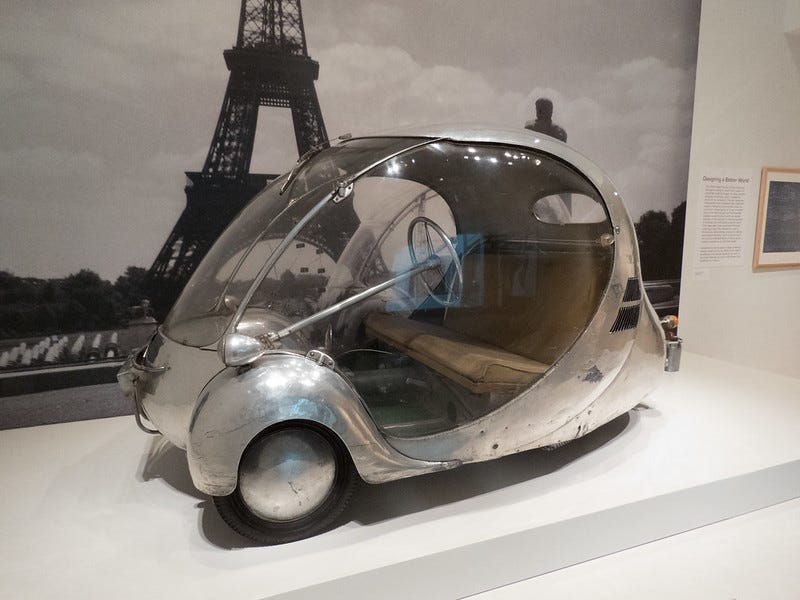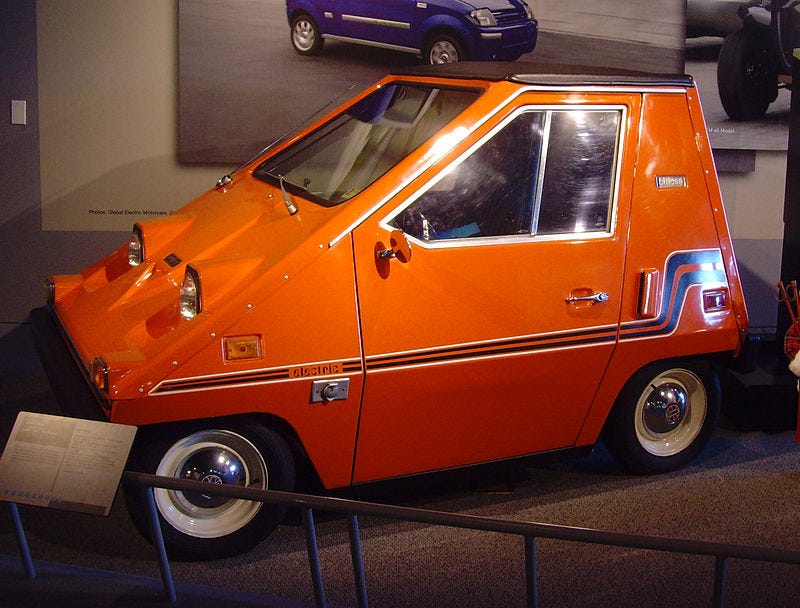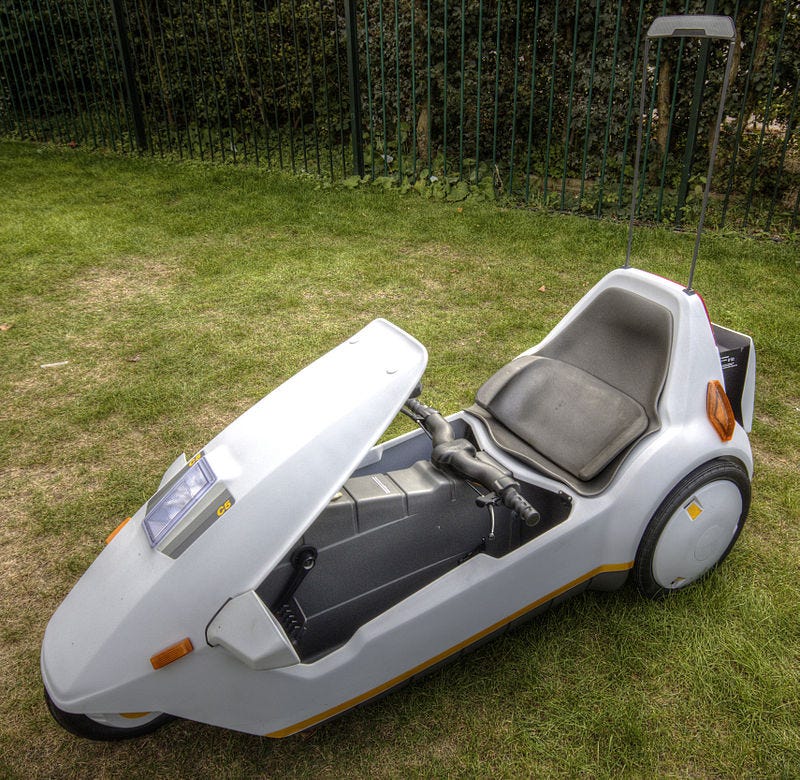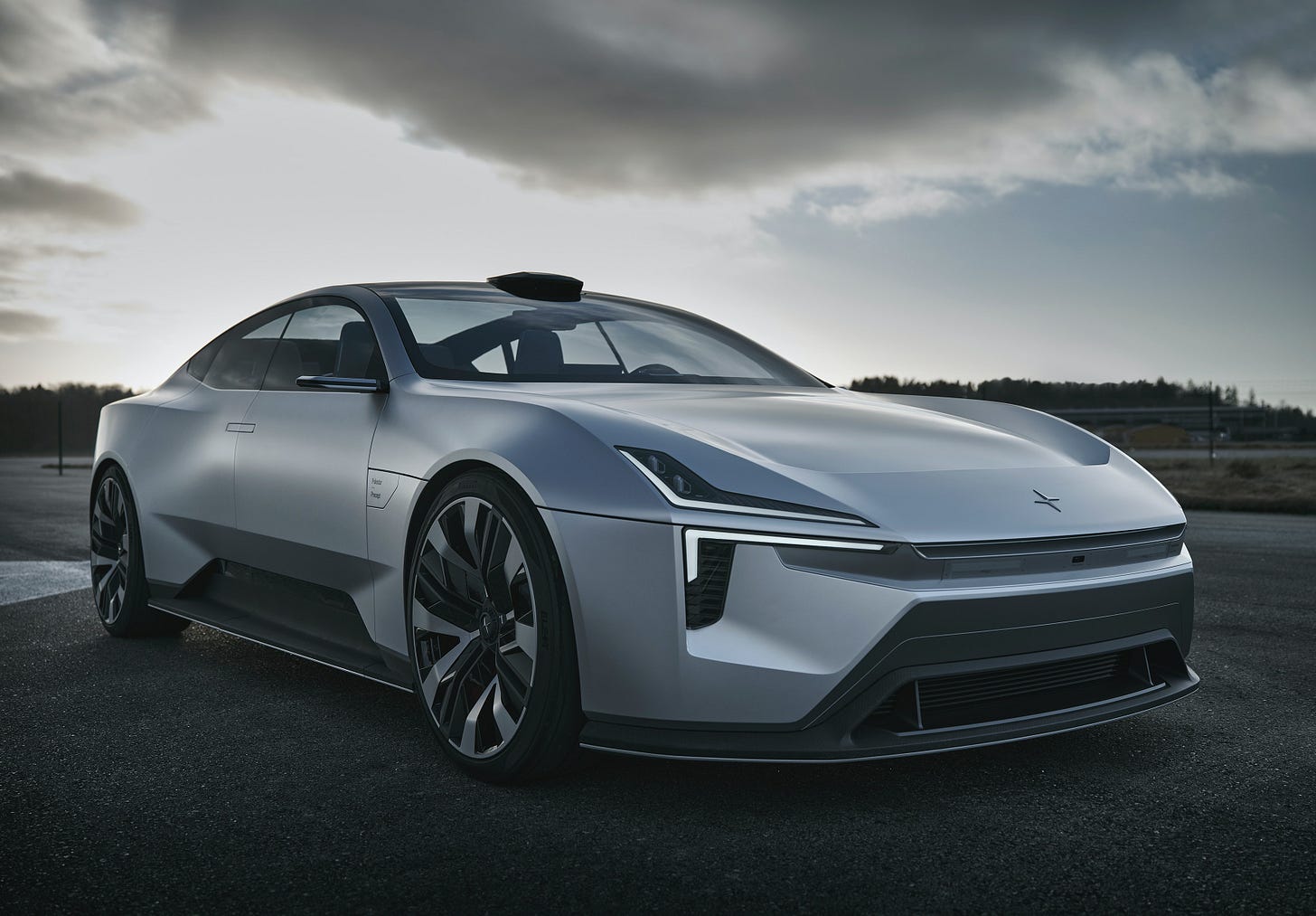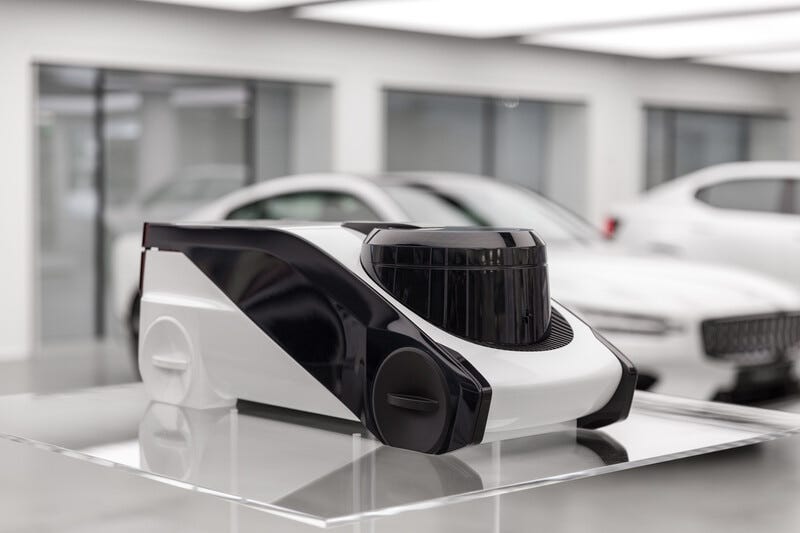⚡️ Electric car design is entering a radical new phase
Musk Reads+ #19
Electric cars have gone from strange wedge shapes to more traditional designs — but the future is set to branch out in new and exciting directions. It’s all in this subscriber-only edition of Musk Reads+ #19.
Surprise! Today we're giving everyone a preview of the full Musk Reads+ experience. To dive deeper with more exclusive interviews and analysis, subscribe today.
Are you a new subscriber? Tell us a bit about yourself! Reply to this email with your first name, city, and your coolest Tesla or SpaceX photo. We’ll share the highlights with the rest of the Musk Reads community in a future email.
An Elon enigma
One of Tesla’s big successes was to make electric cars desirable. Early experiments in the field resulted in sometimes bizarre designs. General Motors’ blob-shaped EV1, the firm’s first electric car that hit roads in 1996, was dismissed by HotCars as “downright ugly.”
Tesla’s currently shipping lineup consists of sedans and SUVs that strike a good balance between conventional and futuristic, the impressive work of Franz von Holzhausen. The upcoming Cybertruck, however, seems to be a return to the unconventional. As Tesla plans to design future cars at the Shanghai and Berlin factories, encouraging new talents to leave their mark, the future of electric car design seems fascinatingly open.
Key quote
“Normally when there's a shift in technology, there's also a shift in aesthetics; there's a shift in new ways of engaging with the product. I think we are just about experiencing that change now.”
Max Missoni, head of design at Polestar.
What you need to know:
Polestar held its first annual design competition starting June 2020. Its head of design, Max Missoni, sees the industry at a pivotal moment.
Electric cars used to sport strange designs and weird shapes. Missoni argues that heritage brands were constrained by their history, and design features hung around for decades.
The Arab oil embargo led to the establishment of CAFE rules, which gave manufacturers an incentive to reach a mass market.
Modern electric cars from the likes of Tesla and Nissan sported more traditional designs. That looks to change with more bizarre designs like the Cybertruck.
The Polestar Precept builds on previous designs while thinking about the future of EVs. More space is given to sensors, while recycled materials speak to its eco-friendly design.
Other automakers, like Volkswagen and Byton, are expanding on the emerging design flairs seen in electric cars.
One winner of the annual design competition envisioned a flying machine — perhaps a sign of the next vehicle set to follow a similar trajectory.
Let us know what you think of today’s interview by hitting reply to this email. We’ll feature the best responses in Friday’s newsletter. Thanks for reading!
The deep dive:
On June 23, 2020, electric car maker Polestar announced a global design contest to be held annually. The inaugural contest asked entrants to submit a new design for 2040, one that “stretches the boundaries of imagination” without moving into fantasy — although the final entry didn’t necessarily have to be a car.
The contest comes as the future of electric car design looks more exciting than ever. Once relegated to oddly shaped boxes and blobs, EVs broke into the mainstream with more traditional designs from the likes of Nissan and Tesla. Now, fresh with confidence about the category’s solidifying foothold, the future of EV design looks set to break free from its gas-powered roots.
“We see a lot of conventions that have been the same for so many decades in the car industry,” Missoni says. “Normally when there's a shift in technology, there's also a shift in aesthetics; there's a shift in new ways of engaging with the product. I think we are just about experiencing that change now.”
The history of the electric car is riddled with oddities. At the start of the 20th century, they accounted for one-third of vehicles on American roads. But by the 1920s, cheap fuel and a desire to travel long distances had led to the rise of the gas-powered car.
Missoni argues that heritage traditionally played a big role in the car industry. Automakers would feel confined by engineering feats, which would become iconic and inspire product lines for decades — just look at the swooping silhouette of a Porsche 911. That’s not the case for a new electric car brand like Polestar.
“We can define our own segments,” Missoni says. “We can define our own car types. We are not confined to certain archetypes of vehicles that other brands traditionally have in their lineup and need to follow up with successors.”
During the post-1920s electric car lull, a fascinating stream of creative designs emerged. Free to envision a greener future, unshackled from the constraints of gas guzzlers and heritage brands, designers would seemingly let their imagination run wild.
Take Paul Arzens’ creation. The French designer unveiled “L’œuf electrique” in 1942, an egg-shaped three-wheeler designed to snake the streets of Paris. It had a top speed of 37 mph and range of around 60 miles.
Another EV was the Sebring-Vanguard CitiCar. This 1974 wedge on wheels could go for 40 miles per charge. HotCars, in its list of 10 ugliest EVs, dismissed it as “little more than a glorified golf cart.” Perhaps that was fitting, as it was a well-known application of the technology. A 1956 issue of Popular Mechanics described the electric golf cart as “the most popular on the nation’s courses.”
One famous foray came from Sir Clive Sinclair, a British inventor who unveiled the Sinclair C5 in 1985. The BBC notes it was marketed as neither a bike nor a car, a reimagining of urban transport paired with a push toward electrification.
The project was born out of earlier attempts to create a full-blown electric car, the C1, which was hampered by technology at the time. The C5’s strange seating position and 15 mph top speed meant the market didn’t take it seriously. Production didn’t even last a year.
A 1973 oil dispute is sometimes credited with helping to pull electric cars out of their awkward phase. The Arab world placed an embargo on the United States in response to the latter country supplying the Israeli military. During the gas shortage, the United States established the corporate average fuel economy standards, which covered the fuel consumption of a manufacturer’s entire fleet.
Aaron Dale, analyst at IHS Markit, explained to Inverse in May 2017 that average carbon emissions rules encouraged automakers toward selling electric cars to balance their product range. “It then gives them a little more freedom to develop products at the top end...without that lineup of EVs, you’re going to have to have broadly average compliance in CO2 across the portfolio.”
An industry pushed toward efficiency, paired with improvements in technology, set the stage for the future. General Motors’ EV1, released in 1996, is credited as the first modern electric vehicle. It was also dismissed by HotCars as “downright ugly.” Autocar declared it a “technological triumph,” but noted its heavy 1,150-pound lead acid batteries led to a range of just 90 miles.
In 2017, Musk recommended to his followers to watch the 2006 documentary Who Killed the Electric Car? The film outlines the launch and subsequent scrapping of the EV1.
The 2008 Tesla Roadster, the first mass-produced lithium-ion electric car, was a breath of fresh air with its Lotus Elise stylings. Tesla’s next decade led to more mainstream cars at gradually cheaper price points. Competitors like the Renault Zoe and Nissan Leaf aimed for similarly conventional design. With 2.6 percent of global car sales in 2019, accounting for one percent of cars on the road, the EV is no longer a sidelined curiosity.
A more confident industry is now looking to its next phase. Polestar unveiled the Precept concept in April 2020, which took inspiration from its first two cars while charting a path forward.
“We have developed our design language over the years now, and Precept was the last big puzzle piece to introduce our way forward,” Missoni says.
A Smart Zone packed with sensors runs along the car’s front, replacing the unnecessary large air intake. Side and rear mirrors are replaced with cameras, paired with a 15-inch touchscreen on the inside. Interior materials like recycled polyester and flax linen speak to an eco-focused future, no longer constrained by heritage brands’ use of wood and leather to establish a premium feel.
“We've taken a lot of inspiration from sustainable materials,” Missoni says. “So instead of using leather and wood as premium materials, you go to
recycled, 3D-knitted materials combined with vinyl from biological sources, and by that have, in itself, a new appearance.”
Polestar is not the only one interested in experimenting with new ways forward. While 2017’s Tesla Model 3 looked fairly conventional on the outside, the inside dropped the instrument cluster on the driver’s side in favor of a single touchscreen in the center. The second-generation Roadster, unveiled that same year, took things a step further by also replacing the side mirrors with cameras.
But perhaps the most radical departure came with the Cybertruck, unveiled in November 2019 with a late 2021 launch. The angular design looked more like a grown-up version of the 1974 CitiCar than an evolution of the Model 3, despite the fact that both vehicles were part of the same 2016 plan to reach mass market consumers.
Like the Precept, the Cybertruck also experimented with materials. Musk claimed after the unveiling that the truck looked so bizarre because its body uses a cold-rolled 30X stainless steel. Shaping the body would have broken the stamping press.
Others are branching out in their own ways. The Byton M-Byte takes the touchscreen trend to the logical conclusion, packing a 48-inch screen that stretches across the front dashboard. Volkswagen’s ID Space Vizzion builds on aerodynamic enhancements, ideal for electric car range with stylized aero wheels and a complete lack of door handles. The latter car should drive for 435 miles when it launches in 2023.
Amid these cautious steps into the future, students are taking note. Missoni says that as electric cars enable new layouts for technical components, more sustainable materials, and an overall shift in car design, these trends are also emerging in schools.
“That shift is happening,” Missoni says. “You can see that in design schools all over the world that students are starting to embrace these topics.”
Beyond the design competition, Polestar has worked to bring these students in. Its Instagram account, “Polestar Design Community,” has over 25,000 followers.
The account shows some fascinating flourishes from Polestar fans. This one, from design student Dongliang Wang, has some Roadster-inspired stylings for a supercar of the future.
Another, from Franklin Guo, takes inspiration from famed industrial designer Dieter Rams.
Missoni has noticed more academic projects around Polestar, where traditionally students would choose established brands.
“Students are very much at the pulse of what's happening, and it was quite interesting to see how quickly they picked us up as a new player,” Missoni says.
Polestar is not the only one encouraging this new generation. Musk has announced his goal to design Tesla vehicles in Berlin and Shanghai, reducing the company’s current focus on American designs.
On December 12, 2020, Polestar announced the winners of its 2040 design competition. The professional category’s winner was Poland-based Konrad Cholewka. His “Polestar MMXL” design took these small steps and imagined the far future results.
The Smart Zone extends out into a series of lidars on each wheel, enabling autonomous driving. A single large and cozy space highlights the shift from driver-focused design to passengers in an autonomous car. Recycled materials feature throughout.
True to the competition’s suggestion, the student category winner was an airship design dubbed “Polestar 40.” The radical design used helium to carry a yellow open view cabin with tilting rotors on the rear for flight navigation.
An airship seems like a surprise winner for a car brand’s design competition. But as brands like Tesla and Uber express interest in the vertical takeoff and landing space, a focus on aviation could prove prescient.
Indeed, Musk has stated on several occasions that the limiting issue is battery density. An electric flying machine would require a dense enough battery to lift itself, a figure Musk placed at 400 watt-hours per kilogram. In June 2020, Musk wrote that one fan concept of a Tesla electric jet “looks pretty cool.”
As this next space develops, it could end up as the next vehicle to follow a similar design path of the electric car.
Musk Reads+ Archive
New to our newsletter? Catch up on some of our previous exclusives. And if you’re not already subscribed, consider contributing!
Josh Giegel predicts when you’ll be able to ride Hyperloop.
Jordan Giesige reveals what’s going on with Tesla’s future batteries.
Tesla analysts detail what you should know before buying stock.
Werner Herzog criticizes the Mars city.
Peter Beck explains how Rocket Lab is forging a new path.
What it’s really like to witness a rocket launch.
The ultra-fine print:
This has been Musk Reads+ #19, a new subscriber-only report about the worlds related to futurist and entrepreneur Elon Musk. I’m Mike Brown, an innovation journalist for Inverse.
Email me directly at mike.brown@inverse.com and follow me on Twitter @mikearildbrown.
Follow Inverse on Twitter @inversedotcom.
Enjoyed today’s email? Why not share it with a friend?
What did you think of today’s interview? Hit reply to this email to tell us your thoughts.
Thanks for reading!


